
This page is part of © FOTW Flags Of The World website
Burundi - Historical flags
Last modified: 2025-04-19 by bruce berry
Keywords: burundi | sabena | drum | sorghum | karyenda | error | star: 6 points (fimbriated) | stars: triangle | stars: 3 | star: 6 points |
Links: FOTW homepage |
search |
disclaimer and copyright |
write us |
mirrors
See also:
Background
Prior to independence on 01
July 1962 Burundi was part of German East Africa.
After its defeat in World War I, Germany handed control of
part of German East Africa to Belgium. On 24 October 1924
this territory, which consisted of modern day Rwanda and
Burundi became a Belgian League of Nations mandate
territory known as Ruanda-Urundi and was part of the Belgian colonial Empire
linked to the neighbouring Belgian Congo. Following
World War II, Ruanda-Urundi became a United Nations Trust Territory under
Belgian administrative authority. During the 1940s pressure for local autonomy
increased and on 20 January 1959 Burundi’s local ruler, Mwami Mwambutsa IV,
requested a separation of Burundi and Rwanda and the dissolution of
Ruanda-Urundi. Burundi proclaimed independence on 01 July 1952
with Mwami Mwambutsa IV as king.
The flag adopted at independence consisted of a white saltire which divides the
field into alternating red and green areas. The centre of the saltire merges to
form a white disc, which contained a Karyenda (drum
symbol of royalty) and sorghum plant (symbol of prosperity). When the
monarchy was deposed in 1966 the Karyenda was removed from the flag
leaving only the sorghum plant in the centre. The current flag maintains
the original design but with three red six-pointed stars outlined in green being
placed on the central white disc. The flag was originally adopted in 1967 with
the overall ratio of 3 : 5 being set in 1982. The three stars in the centre of the
flag officially refer to the three words in the national motto “Unité,
Travail, Progrčs” (French for “Unity, Work, Progress”). The three stars are
also said to represent the three ethnic groups who live in Burundi, namely the
Hutu, Tutsi and the Twa. The colours represent hope (green), peace (white) and
the struggle for independence (red).
The historical timeline of major political events is as
follows:
- Area comes under German control (1903) and later becomes part
of German East Africa
-
League of Nations mandate (Belgium)
and establishment of Ruanda-Urundi
(20 July 1922)
- Administrative union with Belgian Congo
(1926-1960)
- United Nations Trust Territory (1946-1961)
- Local autonomy granted in 1961
- Independence granted on 01 July1962 as a
monarchy under King Mwambutsa IV
- Abolition of the monarchy and proclamation
of a republic on 28 November 1966.
Possible flags used at
the time of independence
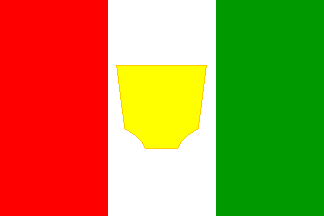 image
by Jaume Ollé, 20 Jan 1997
image
by Jaume Ollé, 20 Jan 1997
Initially the flag had vertical stripes of red, white,
green, with golden emblem (a drum) in center.
This flag was in use around 1961-62.
Posted to me by Jorge Hurtado, editor of
Banderas.
Jaume Ollé, 20 Jan 1997 and 05 Sep 1998
The source of this flag is very unreliable:
If I remember correctly, this flag was redesigned after
a newspaper report which said that "in Burundi was
hoisted a flag of red, white and green with a Royal drum
on it" . So this illustration might be nothing
more than a poor reconstruction of the
1962 flag.
Ralf Stelter, 13 Jun 1999
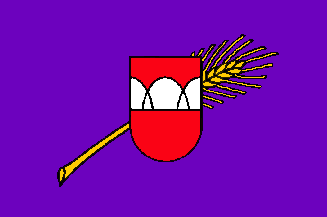 image
from World Statesman located by Zane Whitehorn, 11 Nov 2002 and updated
by António MARTINS-Tuválkin, 03 Oct 2017
image
from World Statesman located by Zane Whitehorn, 11 Nov 2002 and updated
by António MARTINS-Tuválkin, 03 Oct 2017
At the World Statesmen website there is a historical Burundi flag
as pictured above.
The flag
is purple with what I presume is a wheat stalk behind a red shield. The shield has interlocking white semicircles.
The status of the flag is unknown.
Zane Whitehorn, 11 Nov 2002
First national
flag (1962-1966)
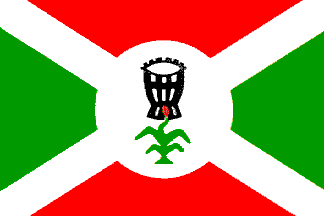 image
by Pascal Gross, 22 Aug 1998
image
by Pascal Gross, 22 Aug 1998
At the independence in 1962 until 1966 Burundi used a flag based on the current
design but with a drum called the Karyenda, a
traditional emblem of the Mwami (king) in the centre. There was also a
sorghum plant placed in front of the Karyenda.
Stuart Notholt, 12 Mar 1996There are also
reported variants where the colour of the drum
is red and the position of the drum and sorghum is different as shown below.
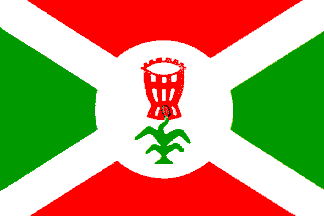 image
by Pascal Gross, 22 Aug 1998
image
by Pascal Gross, 22 Aug 1998
On independence day, the flag adopted was in the current
design but with a sorghum plant and the drum (in
red) in the centre. This flag is shown on a postage stamp issued on
the independence day.
The image above is one of several known variants.
Jaume Ollé, 05 Sep 1998
The king (a Tutsi) appreciated similarity between a red
drum and a Hutu axe and ordered the flag to be changed. The rendition
of the drum is also more complex as shown in several books.
Jaume Ollé, 05 Sep 1998
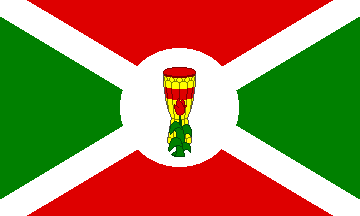 image
by Blas Delgado Ortiz, 07 April 2001 based on image scanned by Jarig Bakker,
09 Oct 2000,
from the flag chart of 'De Gei"llustreerde Pers' (Amsterdam, 1965)
image
by Blas Delgado Ortiz, 07 April 2001 based on image scanned by Jarig Bakker,
09 Oct 2000,
from the flag chart of 'De Gei"llustreerde Pers' (Amsterdam, 1965)
The
drum/plant emblem on top of the shield appears in
Burundi coins issued in 1962.
Other Burundi coins, issued in 1965,
show the drum/plant emblem on top of the shield. It seems
strange that there is such a great difference on how the drum/plant
is portrayed in the coins with the one portrayed in the flags.
Dimitris Kiminas, 25 Sep 2000
When the monarchy was overthrown in 1966, these
symbols were abandoned.
Stuart Notholt, 12 Mar 1996
I have three photographs from 1962 that might tell an interesting story about
the design of Burundi's original flag.
The following two photos were taken in the Usumbura before independence:
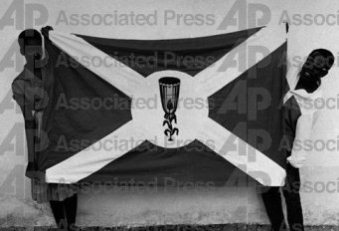
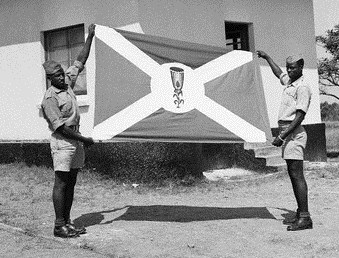 images
sent by Brendan Hennessy, 20 Jan 2013
images
sent by Brendan Hennessy, 20 Jan 2013
Note that the two flags are almost the same - The drum is tall and
detailed and the sorghum plant's leaves are close to the stem. But the second
photo's caption says, "Here, two recruits hold the new Burundi flag in a photo
made a few days before the 01 July independence became effective. Mwami
Mwambutsa, the ruler of Burundi, noticed that the tom-tom in the new flag is
more Bahutu than Watusi in design, and has ordered all flags to be scrapped and
design to be changed, reliable sources said."
Now look at this photo of the actual independence ceremony in Usumbura:
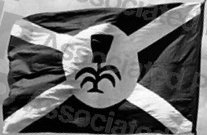 image sent by Brendan Hennessy, 20 Jan 2013
image sent by Brendan Hennessy, 20 Jan 2013
The design of this flag is different. The drum is shorter and
wider with no details, and the sorghum plant's leaves extend out further from
the stem. The same design appears on a commemorative stamp a few months later.
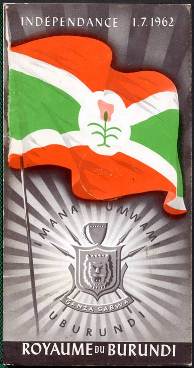 image
sent by Brendan Hennessy, 20 Jan 2013
image
sent by Brendan Hennessy, 20 Jan 2013
I think this second flag, the one that was raised and adopted on 01 Jul 1962,
might be the replacement that Mwambutsa ordered. That would explain the lack of
detail — it would have had to be made incredibly fast to be ready for the
independence ceremony ceremony.
Brendan Hennessy, 20 Jan 2013
![[Arms of Burundi]](../images/b/bi-1962-66.gif) image by Martin
Grieve, 27 December 2024
image by Martin
Grieve, 27 December 2024
Re-constructed flag of Burundi 1962-1966:
Overall Ratio: 30 x 45 units
Width of diagonals: 4.5 units
Diameter of circle: 15 units
Height of
central device: 11 units
I also provide a screenshot from a short
film of the last King's inauguration in 1966 (Ntare V Ndizeye). The shot is in
colour but it is difficult to make out the shades accurately, even when
lightened in photoshop. It appears (thus far!) then that the multi-coloured drum
version
was no more than a failed proposal.
Martin
Grieve, 27 December 2024
![[Arms of Burundi]](../images/b/bi)1962.gif) image by Martin
Grieve, 27 December 2024
image by Martin
Grieve, 27 December 2024
Coat of Arms re-constructed from an illustration provided on Hubert deVries
website at
http://www.hubert-herald.nl/INHOUD.htm
The coat of arms is red with a gold lion mask. For unknown reasons it is
identical to the coat of arms of the Belgian 1st Army Corps The shield shows the
state drum in the natural colors. The shield rests on four crossed spears that
have the same meaning as the spears in the former insignia of the chieftains.
The motto from the Belgian period was retained and is on a ribbon under the
shield. The motto mentioned in the constitution is placed in a semicircle above
the coat of arms and translated into Burundi as “IMANA . UMWAM . UBURUNDI.
Martin Grieve, 27 December 2024
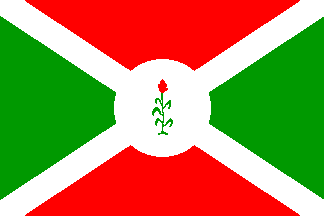 image
by Joán-Françčs Blanc, 10 Jan 2000
image
by Joán-Françčs Blanc, 10 Jan 2000
After 29 November 1966 the monarchy fell and the drum
was removed from the flag leaving only the sorghum plant in the centre of the
flag.
This period is a bit confused. According to DGF-Nachrichten
(Issue 10) a flag was used without the drum or the sorghum plant for
two days between 27-28 November 1966.
Jaume Ollé, 05 Sep 1998
From 1962 until September 1966 the circle in the center
of the flag bore the royal drum and a sorghum plant, and from
September until November 1966 the sorghum alone.
Nozomi Kariyasu, 12 Jan 2000, quoting from
Mucha's Encyclopedia, 1985
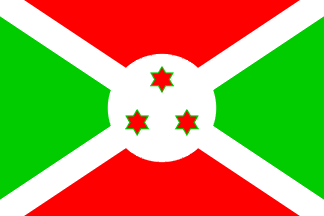 image by Mark Sensen and António Martins, 15 Nov 1999
image by Mark Sensen and António Martins, 15 Nov 1999
Three red stars, fimbriated in green, were added to the centre of the flag in
1967. The one-over-two arrangement of the stars is illustrated
on a postage stamp to commemorate the 4th anniversary of the Republic in
1970. Although the ratio of the flag was fixed on 27 September 1982
as being
3:5, between 1967 and that date the de facto
ratio was 2:3.
The three
stars in the centre of the flag officially refer to the three words in the
national motto “Unité,
Travail, Progrčs” (French for “Unity, Work, Progress”). The three stars are
also said to represent the three ethnic groups who live in Burundi, namely the
Hutu, Tutsi and the Twa. The colours represent hope (green), peace (white) and
the struggle for independence (red).
Jaume Ollé, 05 Sep 1998
Incorrect version
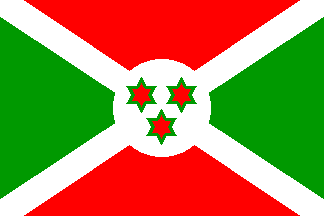 image
by Mark Sensen and António Martins-Tuválkin, 15 Nov 1999
image
by Mark Sensen and António Martins-Tuválkin, 15 Nov 1999
On 28 July 1967 the fimbriated stars were added to the flag.
This flag is shown on a 1967 postage stamp to commemorate the first anniversary
of the republic with stars arranged two in the upper part and one in the lower part.
Jaume Ollé, 05 Sep 1998
Burundi's flag was never with two stars on top. The image on
the postage stamp is incorrect.
Ralf Stelter, 09 Dec 2000
 image
by Pascal Gross, 22 Aug 1998
image
by Pascal Gross, 22 Aug 1998
 image
by Jaume Ollé, 20 Jan 1997
image
by Jaume Ollé, 20 Jan 1997 image
from World Statesman located by Zane Whitehorn, 11 Nov 2002 and updated
by António MARTINS-Tuválkin, 03 Oct 2017
image
from World Statesman located by Zane Whitehorn, 11 Nov 2002 and updated
by António MARTINS-Tuválkin, 03 Oct 2017 image
by Pascal Gross, 22 Aug 1998
image
by Pascal Gross, 22 Aug 1998




![[Arms of Burundi]](../images/b/bi-1962-66.gif)
![[Arms of Burundi]](../images/b/bi)1962.gif)
 image
by Joán-Françčs Blanc, 10 Jan 2000
image
by Joán-Françčs Blanc, 10 Jan 2000

 image
by Mark Sensen and António Martins-Tuválkin, 15 Nov 1999
image
by Mark Sensen and António Martins-Tuválkin, 15 Nov 1999